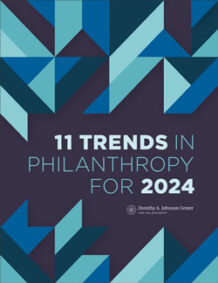The Artificial Intelligence Revolution Arrives in Philanthropy


 This article was first published in our 11 Trends in Philanthropy for 2024 report. Explore the full report here.
This article was first published in our 11 Trends in Philanthropy for 2024 report. Explore the full report here.
Want the latest trends, research, and more delivered right to your inbox? Subscribe to the Johnson Center email newsletter.
In the past twelve months, The Chronicle of Philanthropy, Alliance Magazine, Inside Philanthropy, and many more have all published content that both explores and predicts the future of artificial intelligence (AI) and its impact on the philanthropic sector. While AI is not a new field, it has received an enormous amount of attention and interest in the past year. According to Google Trends, the popularity of the search term “artificial intelligence” dramatically increased in 2023, reaching an all-time high in April following the release of Chat GPT, Bing Chat, and Bard by Google (Open AI, 2022, & Mehdi, 2023).
This is also not the first time the Johnson Center has included AI in our annual 11 Trends in Philanthropy report. The topic first appeared in 2020, when Adriana Paz observed, “New sources of data, new technologies, and new analytical approaches [including artificial intelligence and machine learning], if applied responsibly, can enable more agile, efficient, and evidence-based decision-making” (para. 12). Again in 2022, Kallie Bauer (author here) explored the application of artificial intelligence and machine learning by nonprofit organizations in “Nonprofits are Finding New Ways to Get the Data They Need.”
Both of these previous references focused on the role of AI in expanding access to and the usefulness of data in the sector. Since these trends were written, the number of artificial intelligence tools that are both low- to no-cost and available for supporting other aspects of the work — such as writing and fundraising — has increased. In addition, the type of AI leveraged in these free tools is evolving and increasingly easy to use.
“With cost no longer the primary barrier to entry, nonprofits and foundations who invest the necessary time and capacity into exploring these new tools and commit to using them responsibly will benefit the most from this emerging technology.”
This is the aspect of the artificial intelligence revolution that has the largest implications for philanthropy. With cost no longer the primary barrier to entry, nonprofits and foundations who invest the necessary time and capacity into exploring these new tools and commit to using them responsibly will benefit the most from this emerging technology.
Artificial intelligence has been in use in select settings since the 1950s (Anyoha, 2017). Its wider use among organizations of all sizes and purposes, however, has been a more recent development. As Inside Philanthropy (IP) pointed out in July 2023, philanthropy has been playing its own role in this evolution, with major philanthropists, many of whom made their money in tech to begin with, leading the way (Karon). According to IP’s reporting, Eric and Wendy Schmidt committed $400+ million to AI, the late Paul Allen increased support by $125+ million for the Allen Institute for AI, Fred Luddy donated $60+ million to establish an AI research initiative, other donors, plus foundations like Ford, Rockefeller, and MacArthur, have committed close to $1 billion in the past decade to studying, advancing, and setting up safeguards for AI.
As AI increased in sophistication, the technology began to branch in two different directions, now known as “traditional AI” and “generative AI.” Emily Heaslip (2023) describes the difference: traditional AI, also known as Narrow AI or Weak AI, is a “subset of artificial intelligence that focuses on performing preset tasks using predefined algorithms and rules” (para. 3). Examples of traditional AI include voice assistants like Siri or Alexa, language translation tools, and spam email filters.
Generative AI, on the other hand, is the next generation of artificial intelligence — with a comparatively recent entry into the public space. Also known as Strong AI or Creative AI, generative AI uses algorithms to create new content, including text, audio, code, and images (Heaslip, 2023). Newly familiar tools like ChatGPT, released November 2022, (OpenAI), and Bard by Google, released in early 2023, fall into the generative AI category. It is this form of AI that is rapidly creating opportunities for foundations and nonprofits of every size to benefit from this technology — and the sector is quickly coming on board.
Daniel Hadley (2023), in an article for The Chronicle of Philanthropy, explored the potential ways generative AI tools can create efficiencies and simplify work previously done by experts in the nonprofit sector. Hadley suggested generative AI would reduce the cost of fundraising, developing marketing campaigns, bookkeeping, research, hiring, and evaluation.
Meredith Gray (2023), in an article for Nonprofit Tech for Good, also suggested 12 ways AI generative tools could assist nonprofits with fundraising, including stewarding and engaging donors, engaging volunteers and board members, and sharing impact.
Historically, AI tools were limited to academia and businesses (Karon, 2023). Today, more businesses offer both traditional and generative AI tools for the philanthropic sector. Examples include:
Founded in 2017, Dataro raised $2.5 million in funding in 2021 to provide its artificial intelligence support services to nonprofits (Ogg, 2021). Dataro may represent a third frontier where traditional and generative AI systems work in tandem (Marr, 2023). Dataro uses generative AI tools that assist with grant proposal writing and fundraising, it also uses traditional AI and machine learning to analyze fundraising data and identify individuals with the highest probability of giving.
The generative AI platform Grant Assistant is a 2023 start-up aimed especially at supporting grantwriters going after complex institutional grants from groups like the U.S. Agency for International Development, the European Union, and the National Institutes of Health (Wiggers, 2023).
Since tools like these are relatively new entrants to the public sphere, there is not a substantial amount of case studies available that discuss how nonprofits are leveraging this technology in their day-to-day work. On Reddit, users discuss anecdotal applications of ChatGPT in their nonprofit work. User netherlane (2023) posted,
I’ve been using it to answer some proposal questions that call for a specific variations [sic] on something I’ve got previously answered on the boilerplate or other proposals. For example, if the rfp asks for an answer in 300 words and I’ve previously answered that question in 1000, then I feed the 1000-word answer to GPT and ask it to summarize that answer in 300 words.
Similarly, user allhailthehale (2023) posted,
The most useful application I’ve found is drafting letters of support. When I ask a partner for a letter of support for a grant I draft something for them to make it easier. Chat GPT allows me to rephrase each one and make it a little more specific to them without spending a ton of time on each.
In both examples, generative AI tools allowed nonprofit staff to accomplish their work more efficiently.
Allhailthehale. (2023). Using ChatGPT for nonprofits? Reddit. https://www.reddit.com/r/nonprofit/comments/11nyd6h/using_chatgpt_for_nonprofits/
Anyoha, R. (2017, August 28). The history of artificial intelligence. Science in the News, Harvard University. https://sitn.hms.harvard.edu/flash/2017/history-artificial-intelligence/
Bauer, K. (2022, January 18). Nonprofits are finding new ways to get the data they need. 11 trends in philanthropy for 2022. Dorothy A. Johnson Center for Philanthropy. https://johnsoncenter.org/blog/nonprofits-are-finding-new-ways-to-get-the-data-they-need/
Chan, K., & Lawless, J. (2023, November 1). Countries at a UK summit pledge to tackle AI’s potential ‘catastrophic’ risks. AP. https://apnews.com/article/artificial-intelligence-risks-uk-summit-kamala-harris-885d09550b0ad19f7a1cdfbd6e2b910b
Fundwriter.ai. (n.d.). Say hello to your new fundraising assistant. https://www.fundwriter.ai
Google. (n.d.) Bard. A conversational AI tool by Google. https://bard.google.com/
Google Trends. (2023). Artificial intelligence. https://trends.google.com/trends/explore?date=today%205-y&geo=US&q=%2Fm%2F0mkz&hl=en
Grantable. (n.d.) Let your purpose flow. https://grantable.co/
Grantboost. (n.d.) Boost your impact. https://www.grantboost.io/
Granted AI. (n.d.) You have better things to do with your time. https://grantedai.com
Gray, M. (2023, April 2). 12 ways to use ChatGPT and other AI tools for fundraising. Nonprofit Tech for Good. https://www.nptechforgood.com/2023/04/02/12-ways-to-use-chatgpt-and-other-ai-tools-for-fundraising/
Hadley, D. (2023, January 4). Artificial intelligence can help nonprofits reach more donors, fundraisers can’t ignore potential pitfalls. The Chronicle of Philanthropy. https://www.philanthropy.com/article/artificial-intelligence-can-help-nonprofits-reach-more-donors-but-fundraisers-cant-ignore-potential-pitfalls
Heaslip, E. (2023, October 16). What’s the difference between traditional and generative AI? U.S. Chamber of Commerce. https://www.uschamber.com/co/run/technology/traditional-ai-vs-generative-ai
Kanter, B., & Fine, A. (2023, June 8). Is your nonprofit thinking about using ChatGPT? Your first step is to do no harm. Candid. https://blog.candid.org/post/why-the-first-step-for-nonprofits-using-ai-technology-chatgpt-is-to-no-harm/
Karon, P. (2023, July 26). AI is suddenly everywhere, but philanthropy has been involved for years. Here are the top funders. Inside Philanthropy. https://www.insidephilanthropy.com/home/2023/7/26/ai-is-suddenly-everywhere-but-philanthropy-has-been-involved-for-years-here-are-the-top-funders
Marr, B. (2023, July 24). The difference between generative AI and traditional AI: An easy explanation for anyone. Forbes. https://www.forbes.com/sites/bernardmarr/2023/07/24/the-difference-between-generative-ai-and-traditional-ai-an-easy-explanation-for-anyone
Mehdi, Y. (2023, February 7). Reinventing search with a new AI-powered Microsoft Bing and Edge, your copilot for the web. Microsoft. https://blogs.microsoft.com/blog/2023/02/07/reinventing-search-with-a-new-ai-powered-microsoft-bing-and-edge-your-copilot-for-the-web/
Netherlane. (2023). Using ChatGPT for nonprofits? Reddit. https://www.reddit.com/r/nonprofit/comments/11nyd6h/using_chatgpt_for_nonprofits/
Ogg, M. (2021, December 13). Give-tech startup Dataro raises $2.5m of its own to bolster charity innovation. Business News Australia. https://www.businessnewsaustralia.com/articles/give-tech-startup-dataro-raises–2-5m-of-its-own-to-bolster-charity-innovation.html
OpenAI. (2022, November 30). Introducing ChatGPT. https://openai.com/blog/chatgpt
Paz, A. (2020, January 15). Data science for social impact. 11 trends in philanthropy for 2020. Dorothy A. Johnson Center for Philanthropy. https://johnsoncenter.org/blog/data-science-for-social-impact/
Wells, K. (2023, June 9). An eating disorders chatbot offered dieting advice, raising fears about AI in health. NPR. https://www.npr.org/sections/health-shots/2023/06/08/1180838096/an-eating-disorders-chatbot-offered-dieting-advice-raising-fears-about-ai-in-hea
Wiggers, K. (2023, November 1). Grant Assistant wants to apply generative AI to grant proposals. Tech Crunch. https://techcrunch.com/2023/11/01/grant-assistant-wants-to-apply-generative-ai-to-grant-proposals/amp/